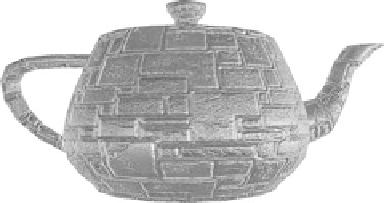Graphics Reference
In-Depth Information
and finally stored in the
fragColor
output variable. The result is a per-
fragment lit object with normal data coming from the normal map.
Many variations are possible on per-fragment lighting. One common
technique is to store the specular exponent in a texture along with a specular
mask value. This allows the specular lighting to vary across a surface.
The main purpose of this example is to give you an idea of the types of
computations that are typically done for per-fragment lighting. The use
of tangent space, along with the computation of the lighting equations in
the fragment shader, is typical of many modern games. Of course, it is also
possible to add more lights, more material information, and much more.
The next rendering technique we cover—related to the previous
technique—is performing environment mapping using a cubemap.
The example we cover is the PVRShaman workspace
Chapter_14/PVR_EnvironmentMapping
. The results are shown
in Figure 14-2.
Figure 14-2
Environment Mapping Example
The concept behind environment mapping is to render the reflection of
the environment on an object. In Chapter 9, “Texturing,” we introduced
cubemaps, which are commonly used to store environment maps. In the
PVRShaman example workspace, the environment of a mountain scene
is stored in a cubemap. The way such cubemaps can be generated is by
positioning a camera at the center of a scene and rendering along each of the
positive and negative major axis directions using a 90-degree field of view. For
reflections that change dynamically, we can render such a cubemap using a
framebuffer object dynamically for each frame. For a static environment, this
process can be done as a preprocess and the results stored in a static cubemap.
The vertex shader for the environment mapping example is provided in
Example 14-3.


